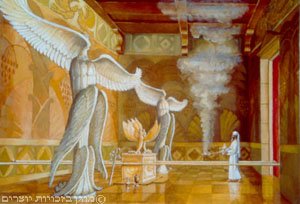The Symbol of Consummate Love Between God and Israel
The Torah portion of Terumah discusses the details of the Sanctuary in which God dwells. The first vessel related to in detail in our portion is the Ark of the Covenant, above which are the two cherubim. While the Holy Ark contains the Torah--God's eternal wisdom--His voice and ongoing directives emanate from between the joined wingtips of the two cherubim, who symbolize the consummate love of delights between God and the people of Israel.
Cherubim--Powers of 2
In the Torah, the cherubim are initially referred to as 2. Each cherub had 4 elements (2 squared):
-
A Body
-
A Face
-
Right Wing
-
Left Wing
When joined together at their wingtips, the cherubim have a total of 8 elements, (2 cubed).
The root of the Hebrew word for the cherubim, kuf-reish-beit also represents 2. The numerical value of the kuf is 20, of the reish 200 and of the beit 2. All of these numbers can be reduced to 2.
The 2s represent the perfect state of love, harmony and delight symbolized by the cherubim. This love serves as the magnet that draws down God's voice to speak to Israel.
Male Symmetry and Female Symmetry
The two vessels in the Temple that reflect perfect symmetry are the Menorah and the cherubim. The menorah's symmetry is relatively male, while the symmetry of the cherubim is relatively female.
Male symmetry is a well-defined axis of 1 in the middle, with an identical number of elements that are present on each side of the axis. In this type of symmetry, there will always be an odd number of elements, another sign of the male state. The Menorah perfectly illustrates this type of symmetry.
Female symmetry has no defined axis, but is rather an even number of elements arranged in a perfectly symmetrical manner.
In the Temple, themale-symmetrical menorah is positioned in the holy sanctuary. The female-symmetrical cherubim are in the Holy of Holies. The epitome of beauty and the symmetry of coupling is female, as also represented by the powers of 2 associated with the cherubim.
Cherubim at the Garden of Eden
The first place that the cherubim appear in the Torah is after Adam and Eve are evicted (in Hebrew, the word for "eviction," gerush, is the same as the word for divorce) from the Garden of Eden. The cherubim assumed a fearful role at the entrance to the Garden, along with the fiery, turning sword. Their role was to ensure that Adam would not re-enter the Garden, eat from the Tree of Life and eternalize the primordial sin.
In this context, the cherubim are a type of angel. Maimonides classifies ten types of angels. According to Kabbalah, these ten types of angels correspond to the ten sefirot. The lowest level of angels, ishim, ("men") are those that converse with prophets or people imbued with the holy spirit. Ishim correspond to the sefirah of malchut. The next level of angels, cherubim, correspond to the sefirah of yesod. They represent the spiritual power of union between man and wife, and symbolize the union between God and Israel.
Baby Face
Our Sages explain that the Hebrew word for cherub, kruv, is from Aramaic and means "as a baby." The cherubim had baby faces. A baby face represents innocence. The loving touch of the cherubim in the Holy of Holies reflects the epitome of pure, innocent love. This innocence exists in the Holy of Holies, in a realm that predates the primordial sin. After the primordial sin, the cherubim also assumed the role of fearful angels.
The Inner Essence of Innocence
The Biblical commentator, Abraham Ibn Ezra, defines the word kruv as formless matter that can assume any form whatsoever. This is the exact property of the cherubim, who can assume the form of fearful angels and also of consummate lovers. Innocence lends itself to this amorphous state, which can assume opposite forms. Amorphousness is also reflected in a baby's face, which assumes a more certain form after the baby matures and manifests his power of free choice. Thus, this ability to strip away one form and to wear another is the inner essence of innocence.
The Ibn Ezra’s Proof
The Ibn Ezra bases his definition of kruv as a formless being on the Workings of the Chariot in the first chapter of Ezekiel. The prophet initially describes four figures: a lion, an ox, an eagle and a man. Later, Ezekiel replaces the ox with a description of a kruv.
Subsequently, Ezekiel describes all the forms as kruvim. The Ibn Ezra concludes from this that the kruv is an amorphous state that can assume any form.
To Innocence and Beyond
The amorphous state of innocence can mature positively, but it also has potential to mature negatively. The state of innocence of Adam and Eve prior to the primordial sin was not meant to be their final state. God intended that they mature to Messianic figures. However, their innocence took a negative turn.
Likewise, our Sages say that Esau and Jacob were relatively unformed until they received da'at at the age of 13, allowing each to make his life choices. The cherubim, as well, had to be made according to most exacting instructions, out of one, solid piece of gold. Our Sages say that even the most minute imprecision in the form of the cherubim would render them as idolatry.
Our goal is to strip away our present form, and to re-adorn ourselves with a mature, Messianic form. When we meditate on the cherubim, we can return to the amorphous, innocent state of female symmetry. This is the first step toward our Messianic goal.

